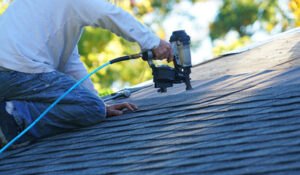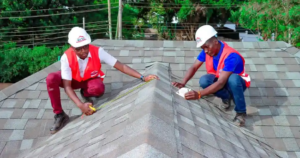If you’re looking to re-roof your home or build a new construction project, metal roofing is an option worth considering. Metal roofs are durable, attractive, and a long-term investment.
Be sure to chalk line the roof carefully and follow the manufacturer’s guidelines for screw placement. This will help prevent putting your warranty in jeopardy. Contact Metal Roofing Columbus GA now!

Residential metal roofing is available in a variety of colors, styles, and finishes that enhance the aesthetic of your home. It is an ideal choice for homeowners looking to enhance the look of their property and make a positive impression on guests or potential buyers. The best part is that you can enjoy the beauty of a metal roof without having to spend a fortune.
Unlike asphalt shingles, which can be dull and grey, and clay or concrete tiles, which can be heavy, which may require additional structural support for the roof, and which often need to be painted regularly, a metal roof can offer a sleek, modern, and appealing design that is a perfect complement to any architectural style. In addition, metal roofs can also be designed to accommodate various accessories such as ridge vents and gooseneck vents that can add both functionality and visual appeal to the roof.
As an added bonus, a metal roof can last for decades with minimal maintenance and is virtually impervious to damage from hail, wind, snow, and other weather elements. This longevity can be a major selling point for any homeowner who is considering listing their home in the future, as prospective buyers will appreciate the fact that they won’t have to worry about a new roof in the near future.
The color of your roof plays a major role in determining its curb appeal, so it is important to choose a color that will complement your home’s existing color scheme. It is also recommended to choose a color that will blend with the surrounding environment and neighborhood aesthetic so your roof doesn’t stick out unnecessarily.
If you are looking for a way to enhance the look of your home and boost its curb appeal, consider installing a metal roof. It is an affordable option that will not only increase your home’s value but will also provide you with a lifetime of durability and energy efficiency. If you are interested in learning more about the benefits of a metal roof, contact us today for a free roofing estimate.
Durability
Metal roofs can add a distinct architectural feature to your home and provide an attractive alternative to traditional asphalt shingles. Many homeowners also choose metal for its durability and longevity, especially in climates that experience frequent storms.
The average metal roof can last 40 to 70 years, with a manufacturer’s warranty to boot. However, factors like the harshness of your local weather conditions, proper maintenance and regular inspections will significantly affect this lifespan. For instance, heavy hail could dent surfaces, while strong winds might test stability.
Another factor to consider is noise. While it is less common than in other roofing materials, some homeowners may be bothered by the sound of rain on a metal roof. Fortunately, this issue can be mitigated with adequate insulation and appropriate installation techniques.
A metal roof can also be more expensive than other roofing types. In addition, the labor required to install a metal roof can be more complex than other roofing systems. This can increase the overall cost of the project and may not be an attractive option for some homeowners.
When choosing a metal roof, it’s important to select a high-quality product. A reputable metal roofing company will ensure that all aspects of the installation adhere strictly to industry standards and promote longevity and durability. In addition, a reputable metal roofing company will be able to offer a range of color options and designs to suit the style of your home.
In general, metal roofs are more expensive than shingle or tile roofing, but they last two to three times longer. The upfront investment can be offset by the longevity and durability of metal, as well as other advantages such as energy efficiency.
Many homeowners are concerned that a metal roof will look industrial or cold, but this is not the case. Today’s metal roofs are available in a wide range of colors and styles to complement the style of any home, from shingle-look to standing seam. Some of these products are even designed to mimic the appearance of a shingle or slate roof for added aesthetic appeal.
Energy Efficiency
At a time when fuel prices are soaring, and more and more people are becoming concerned with their environmental footprint, metal roofing is an ideal solution. While it may initially cost more than shingles, its long lifespan and energy efficiency can offset the initial investment, resulting in considerable savings on utility bills each month.
One of the main benefits of metal roofing is that it reflects sunlight, allowing a structure to stay much cooler than a shingle roof during peak summer temperatures. A roof’s reflectivity is a measure of how well it sends the sun’s rays back into space, with white and light-colored roofs reflecting best. With new technology, however, even dark-colored metal roofs can now meet EPA energy star criteria by using special heat-reflective paint pigments.
While the reflectivity of a metal roof is crucial, another factor in its energy efficiency is its thermal emittance, which determines how quickly it releases its absorbed heat into the atmosphere. A metal roof with high emittance can significantly reduce cooling costs during the summer and help keep a home warm in winter.
In addition to its energy-saving properties, metal roofing is also fire-resistant. Although many people have the misconception that metal roofs attract lightning, this is untrue. In fact, most metal roofing types are considered Assembly-Rated Class A, meaning that the covering and underlying material provide additional fire protection.
A metal roof’s installation method also impacts its performance. For example, a metal roof requires a underlayment to be effective, and the type of underlayment required depends on the roofing’s geographic location and structural design. For example, areas prone to hurricanes need underlayment that can withstand high wind speeds.
While a metal roof has several advantages over other roofing options, it’s important to work with a skilled and experienced roofing professional when installing a metal roof. Poor installation can result in rust, denting, expansion and contraction issues, oil canning, color matching challenges, and the possibility of thermal expansion and contraction, which leads to a wavy or rippling appearance known as “galvanic corrosion.” The roofing professionals at Fortified Roofing can provide expert guidance on choosing the best metal roof for your property and discuss potential installation and maintenance concerns.
Maintenance
Metal roofing requires a little maintenance to stay looking great and working properly. Whether your roof is standing seam or exposed fastener, it’s important to regularly inspect the panels for damage and rust. It’s also a good idea to have a professional inspect the fasteners, rivets, screws, and other hardware, since they are more likely to be impacted by UV light. If they are crooked, loose, or missing, this could allow moisture into the roof and cause water damage over time.
It’s important to inspect metal roofing often, especially if you live in a climate with harsh weather conditions. If you notice rust spots or other signs of corrosion, these should be cleaned and treated as soon as possible to prevent further damage to the roof and surrounding areas of the home. It’s also a good idea for homeowners to inspect the gutter systems regularly and clean them whenever needed to avoid clogs.
Another common maintenance task for metal roofs is to check the sealants on seams and edges for wear and tear. These aren’t as long-lasting as the paint on the panels, so you’ll want to make sure they’re still providing adequate protection against rainwater and debris. Look for cracks, scuffs, mildew, and organic growth as these are all indicators that the sealants aren’t working and that it’s time to replace them.
Surface scratches can be a problem for many roof types, but they’re particularly troublesome for metal roofs. The constant friction against the metal creates abrasions that will eventually lead to rust and leaks. You can use touch-up paint pens to address minor surface scratches, but it’s always best to have a professional examine any extensive damage.
In addition to checking for damage and rust, it’s also important to inspect the flashing around roof penetration points like vents and chimneys. This is an area that is prone to leaks, so it’s important to ensure that the flashing and other sealants are in good condition. If not, they should be replaced immediately. Inspecting these areas can be difficult for homeowners without the right safety equipment, so it’s usually best to leave this type of inspection to a trained professional.


